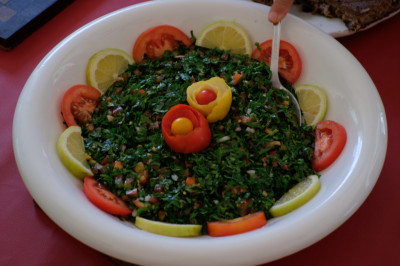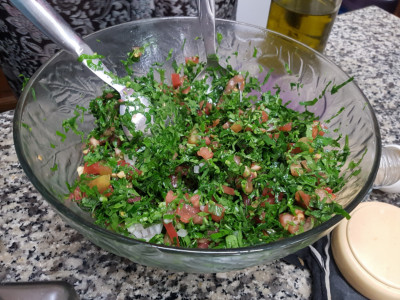Tabbouleh
 “Tabbouleh is to Lebanese cuisine what Baalbeck is to Lebanon’s heritage… an emblem…. An identity”, as Zeina Nacouzi Akiki puts it in her book “Georgette’s recipes”.
“Tabbouleh is to Lebanese cuisine what Baalbeck is to Lebanon’s heritage… an emblem…. An identity”, as Zeina Nacouzi Akiki puts it in her book “Georgette’s recipes”.
 In Lebanon, tabbouleh is a very popular traditional salad and is considered one of the typical dishes of Lebanese cuisine. It is prepared with fresh ingredients such as parsley, mint, tomatoes, onions, bulgur, lemon juice and olive oil.
In Lebanon, tabbouleh is a very popular traditional salad and is considered one of the typical dishes of Lebanese cuisine. It is prepared with fresh ingredients such as parsley, mint, tomatoes, onions, bulgur, lemon juice and olive oil.
The preparation of tabbouleh begins by finely chopping fresh parsley, which is the main ingredient of the salad. Next, finely chopped fresh mint is added, along with diced ripe tomatoes and finely chopped red onions. Soaked bulgur is then added to the mixture. Women often get together to sort and bundle the parsley before chopping it with the rest of the vegetables. It’s a great moment of sociability, during which family news and events are exchanged and commented on. From an early age, girls are involved in the preparation of tabbouleh, especially in sorting the parsley.
Tabbouleh is generally seasoned simply, to bring out the fresh flavours of the ingredients. Freshly squeezed lemon juice, extra virgin olive oil, salt and pepper are used to season the salad. Some may add a little sumacة sour grapes juice or pomegranate molasses for extra flavor, but this can vary according to individual preferences.
Tabbouleh is served fresh and is often accompanied by lettuce, cabbage or vine leaves, to be used as a wrapper for small portions eaten by hand. It is most often served as a mezze or side dish, and is especially present at holiday meals, celebrations, family gatherings and especially on Sundays.
Tabbouleh is appreciated for its freshness, lively flavors and aromatic ingredients. It’s a light, healthy dish that represents Lebanese cuisine and is often associated with a balanced, Mediterranean diet.
In fact, there are many regional and seasonal variations on tabbouleh, differing in the ingredients used or the proportions. Each brings its own distinctive touch to tabbouleh, but they all share the idea of blending fresh ingredients to create a tasty and refreshing salad.

